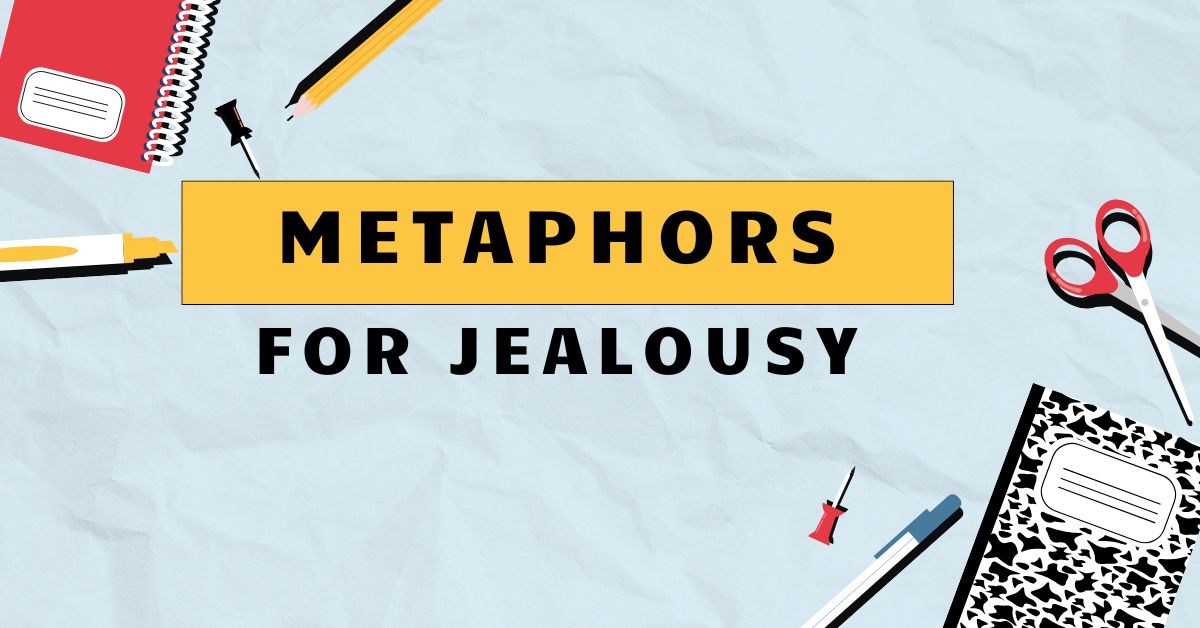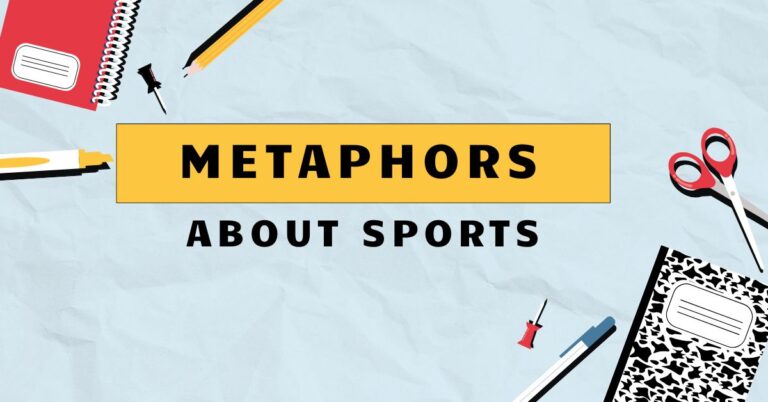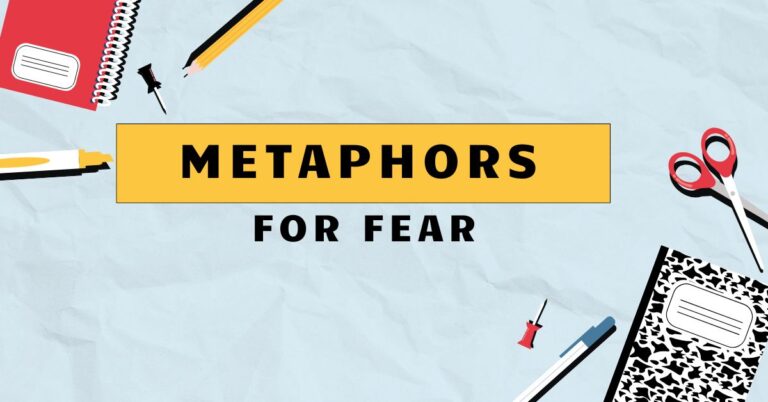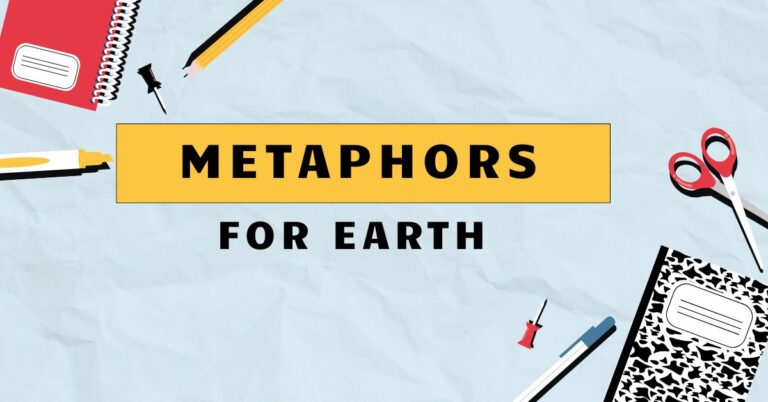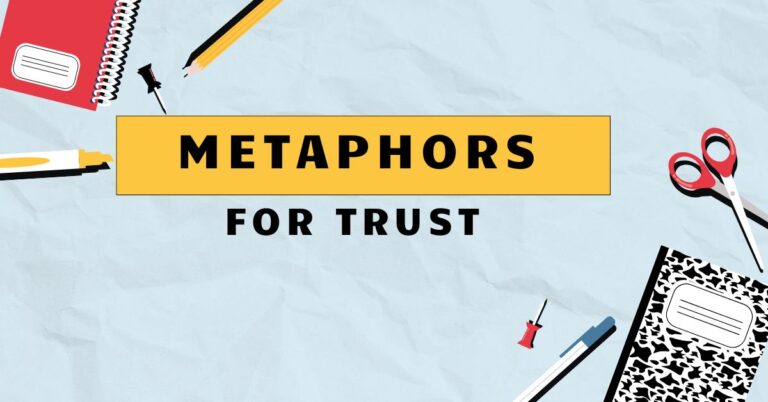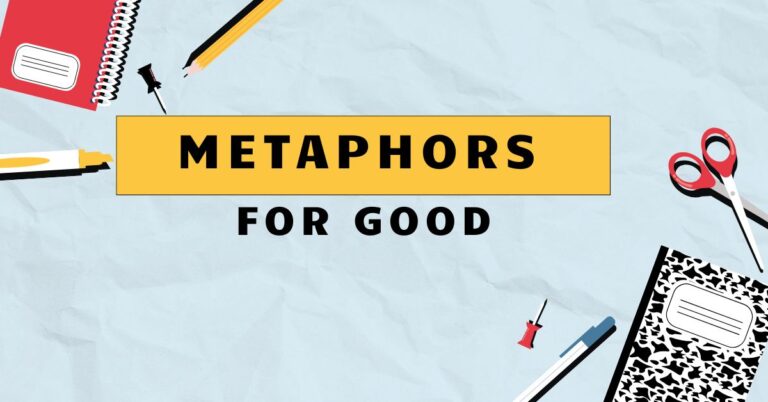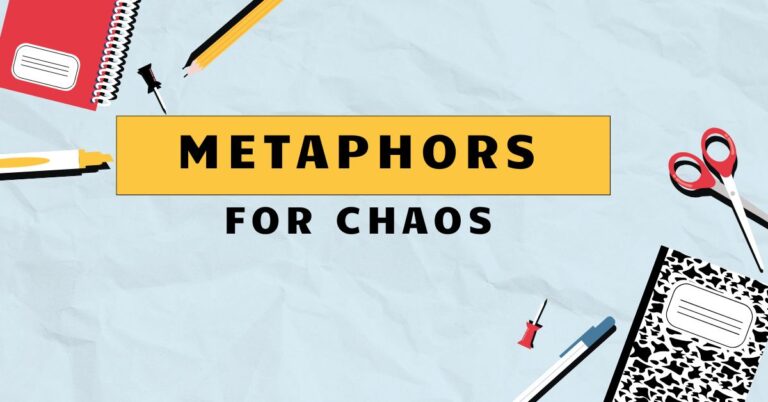29 Metaphors for Jealousy: Understanding Figurative Language
Jealousy, a complex and powerful emotion, often finds expression through vivid and evocative language. Metaphors provide a crucial tool for understanding and conveying the nuances of this emotion.
By exploring the metaphors used to describe jealousy, we can gain deeper insights into its nature and impact. This article delves into the world of metaphors for jealousy, offering a comprehensive guide to their usage, structure, and interpretation.
This resource is designed for English language learners, writers, and anyone interested in exploring the rich tapestry of figurative language.
Table of Contents
- Introduction
- Definition of Metaphor and Jealousy
- Structural Breakdown of Jealousy Metaphors
- Types of Jealousy Metaphors
- Examples of Metaphors for Jealousy
- Usage Rules for Metaphors of Jealousy
- Common Mistakes When Using Jealousy Metaphors
- Practice Exercises
- Advanced Topics in Jealousy Metaphors
- Frequently Asked Questions
- Conclusion
Definition of Metaphor and Jealousy
Ametaphoris a figure of speech that directly compares two unrelated things, asserting that one thing *is* another to suggest a likeness or analogy. Unlike similes, which use “like” or “as” to make a comparison, metaphors create a more implicit and often more powerful connection.
Metaphors enrich language by adding layers of meaning and allowing for creative expression.
Jealousyis a complex emotion characterized by feelings of insecurity, fear, concern, and anxiety over an anticipated or perceived loss of something of personal value, particularly in reference to a social relationship. It often arises from a perceived threat to one’s self-esteem or sense of belonging.
Jealousy can manifest in various ways, from mild unease to intense rage.
Combining these two concepts, metaphors for jealousy are figurative expressions that use unrelated concepts to describe and convey the feeling of jealousy. They help us understand the often-irrational and deeply personal experience of jealousy by relating it to something more tangible or universally understood.
Structural Breakdown of Jealousy Metaphors
Understanding the structure of metaphors is crucial for interpreting and using them effectively. Jealousy metaphors typically consist of two main elements: thetenorand thevehicle.
The tenor is the subject being described (in this case, jealousy), and the vehicle is the concept used to describe it. The connection between the tenor and vehicle is based on shared characteristics or associations.
For example, in the metaphor “Jealousy is a green-eyed monster,” the tenor is jealousy, and the vehicle is a “green-eyed monster.” The shared characteristics include the destructive nature and unsettling feeling associated with both jealousy and monsters. The color green has historically been associated with envy and illness, further reinforcing the metaphor’s power.
The effectiveness of a jealousy metaphor depends on the clarity and relevance of the connection between the tenor and the vehicle. A strong metaphor will resonate with the audience and provide a deeper understanding of the emotion being described.
A weak metaphor, on the other hand, may be confusing or ineffective.
Types of Jealousy Metaphors
Jealousy metaphors can be categorized based on the type of vehicle used to describe the emotion. Here are some common categories:
Jealousy as an Animal
This type of metaphor compares jealousy to various animals, often emphasizing their predatory or territorial nature. The animalistic comparison highlights the primal and instinctive aspects of jealousy.
Jealousy as a Disease
These metaphors portray jealousy as an illness that infects and consumes the individual. This emphasizes the debilitating and destructive effects of jealousy on mental and emotional well-being.
Jealousy as a Fire
Fire metaphors depict jealousy as a burning, destructive force that can quickly spread out of control. This highlights the intensity and potential for damage associated with jealousy.
Jealousy as a Monster
Monster metaphors present jealousy as a terrifying and uncontrollable force that distorts perception and behavior. This emphasizes the irrational and overwhelming nature of the emotion.
Jealousy as a Poison
These metaphors describe jealousy as a toxic substance that contaminates relationships and undermines trust. This highlights the corrosive effects of jealousy on interpersonal connections.
Jealousy as a Burden
Here, jealousy is likened to a heavy weight or obstacle that hinders progress and happiness. This emphasizes the emotional toll and restrictive nature of jealousy.
Jealousy as Darkness
Metaphors that use darkness evoke the hidden, sinister, and obscuring aspects of jealousy, suggesting that it can cloud judgment and create a sense of unease and uncertainty.
Examples of Metaphors for Jealousy
The following tables provide examples of jealousy metaphors, categorized by type. Each example illustrates how the vehicle is used to convey specific aspects of the emotion.
Table 1: Jealousy as an Animal
This table illustrates how jealousy can be compared to various animals, emphasizing their territorial or predatory characteristics to highlight the intense and often irrational nature of the emotion.
| Metaphor | Explanation |
|---|---|
| Jealousy is a viper coiled in her heart. | The viper represents a hidden and venomous threat, suggesting that jealousy is a dangerous and insidious emotion. |
| He felt the dog of jealousy gnawing at his insides. | The “dog of jealousy” is a persistent and painful presence, highlighting the relentless and consuming nature of jealousy. |
| Her jealousy was a lion, ready to pounce. | The lion symbolizes the aggressive and potentially destructive nature of jealousy, suggesting that it can erupt suddenly and violently. |
| Jealousy slithered into his mind like a snake. | The snake represents deceit and hidden danger, indicating that jealousy can be a subtle yet harmful influence. |
| She guarded her relationship like a hawk, fueled by jealousy. | The hawk’s vigilance and possessiveness reflect the protective and controlling aspects of jealousy. |
| His jealousy was a rabid wolf, tearing at his sanity. | The rabid wolf signifies the uncontrolled and destructive nature of jealousy, suggesting it can lead to irrational behavior. |
| Like a caged animal, her jealousy paced restlessly within her. | The caged animal represents the confined and agitated feeling of jealousy, highlighting its internal pressure. |
| Jealousy clawed at him like a wildcat. | The wildcat symbolizes the fierce and aggressive nature of jealousy, suggesting it can be a painful and damaging experience. |
| Her jealousy was a swarm of bees, stinging incessantly. | The swarm of bees represents the constant and irritating nature of jealousy, highlighting its persistent presence. |
| He felt the sting of jealousy like a scorpion’s venom. | The scorpion’s venom symbolizes the painful and toxic effects of jealousy, suggesting it can be a deeply wounding emotion. |
| Jealousy burrowed into her heart like a tick. | The tick represents a parasitic and unwanted presence, highlighting the invasive nature of jealousy. |
| His jealousy was a pack of wolves, hunting for insecurity. | The pack of wolves symbolizes the collective and relentless pursuit of insecurity driven by jealousy. |
| She circled her partner like a vulture, driven by jealousy. | The vulture represents a sense of preying on vulnerabilities, highlighting the possessive aspects of jealousy. |
| Jealousy crept into his thoughts like a spider spinning a web. | The spider spinning a web symbolizes the insidious and trapping nature of jealousy, slowly ensnaring the mind. |
| He protected his position like a bear protecting its cubs, driven by jealousy. | The bear protecting its cubs represents fierce possessiveness and territoriality, emphasizing the protective aspect of jealousy. |
| Jealousy was a hawk circling overhead, always watching. | The hawk circling overhead symbolizes constant vigilance and suspicion, highlighting the watchful nature of jealousy. |
| Like a shark, jealousy lurked beneath the surface of their relationship. | The shark lurking beneath the surface represents hidden danger and potential for sudden attack, highlighting the unpredictable nature of jealousy. |
| Jealousy pecked at her confidence like a crow. | The crow pecking symbolizes persistent and irritating doubt, suggesting jealousy erodes self-esteem. |
| His jealousy was a raging bull, charging at anyone he perceived as a threat. | The raging bull represents uncontrolled anger and aggression, highlighting the violent potential of jealousy. |
| She felt the serpent of jealousy uncoiling in her stomach. | The serpent uncoiling symbolizes a slow, creeping unease that builds to a dangerous level, highlighting the insidious nature of jealousy. |
| Jealousy was the hyena, laughing at his insecurities. | The hyena laughing represents mockery and feeding on vulnerability, emphasizing the demeaning aspect of jealousy. |
| He carried his jealousy like a tortoise carries its shell, a heavy and constant burden. | The tortoise carrying its shell symbolizes a constant and cumbersome weight, highlighting the burden of jealousy. |
| Like a spider spinning its web, jealousy trapped her in a maze of suspicion. | The spider spinning its web represents entrapment and intricate deceit, emphasizing the manipulative nature of jealousy. |
Table 2: Jealousy as a Disease
This table exemplifies how jealousy is frequently portrayed as a disease, emphasizing its detrimental effects on mental and emotional health, and its ability to corrupt and weaken individuals.
| Metaphor | Explanation |
|---|---|
| Jealousy is a virus, infecting their relationship. | The virus represents a contagious and harmful influence, suggesting that jealousy can spread and damage relationships. |
| He was consumed by the cancer of jealousy. | Cancer symbolizes a destructive and relentless force, highlighting the consuming nature of jealousy. |
| Her jealousy was a festering wound, never healing. | The festering wound represents a persistent and painful issue, suggesting that jealousy can be difficult to overcome. |
| Jealousy is a slow poison, eroding their trust. | Slow poison symbolizes a gradual and insidious destruction, highlighting the corrosive effects of jealousy on trust. |
| He suffered from the fever of jealousy. | Fever represents a state of intense and irrational emotion, suggesting that jealousy can lead to erratic behavior. |
| Her mind was clouded by the sickness of jealousy. | Sickness symbolizes a state of mental and emotional impairment, highlighting the distorting effects of jealousy on perception. |
| Jealousy is a parasite, feeding on his happiness. | Parasite represents a draining and unwanted presence, suggesting that jealousy can deplete one’s joy and well-being. |
| He was crippled by the disease of jealousy. | Crippled symbolizes a state of impairment and limitation, highlighting the restrictive effects of jealousy on personal growth. |
| Her heart was infected with the plague of jealousy. | Plague represents a widespread and devastating affliction, suggesting that jealousy can be a destructive force. |
| Jealousy is a malignant tumor, growing in her mind. | Malignant tumor symbolizes a dangerous and uncontrolled growth, highlighting the destructive potential of jealousy. |
| He was drowning in the toxic waters of jealousy. | Toxic waters represent a dangerous and overwhelming environment, suggesting that jealousy can be a suffocating emotion. |
| Her jealousy was a chronic ailment, always present. | Chronic ailment symbolizes a persistent and ongoing issue, highlighting the enduring nature of jealousy. |
| Jealousy is a contagious outbreak, spreading through their group. | Contagious outbreak represents a rapidly spreading and harmful influence, suggesting that jealousy can affect entire social circles. |
| He was weakened by the wasting illness of jealousy. | Wasting illness symbolizes a gradual decline and loss of strength, highlighting the debilitating effects of jealousy. |
| Jealousy was the infection that poisoned their love. | Infection symbolizes contamination and decay, emphasizing the destructive impact of jealousy on love. |
| She was quarantined by her jealousy, unable to connect with others. | Quarantined symbolizes isolation and separation, highlighting the isolating effects of jealousy. |
| His mind was a hospital ward, filled with the sick thoughts of jealousy. | Hospital ward symbolizes a place of suffering and illness, highlighting the mental anguish caused by jealousy. |
| Jealousy festered in her heart like an untreated wound. | Untreated wound symbolizes neglect and prolonged suffering, suggesting jealousy worsens without resolution. |
| He was a patient of jealousy, constantly seeking a cure. | Patient symbolizes helplessness and dependence, highlighting the desperate search for relief from jealousy. |
| Her jealousy was a mental epidemic, consuming her thoughts. | Mental epidemic symbolizes widespread and uncontrollable thought patterns, emphasizing the overwhelming nature of jealousy. |
| Jealousy acted like a silent killer, slowly destroying their bond. | Silent killer symbolizes an unnoticed yet deadly threat, emphasizing the subtle yet destructive impact of jealousy. |
| He was bedridden with jealousy, unable to function normally. | Bedridden symbolizes incapacitation and helplessness, highlighting the debilitating effects of jealousy. |
| Like a spreading rash, jealousy covered every aspect of their relationship. | Spreading rash symbolizes extensive and irritating coverage, emphasizing the pervasive nature of jealousy. |
Table 3: Jealousy as a Fire
The ensuing table presents metaphors that equate jealousy with fire, underscoring its intense, destructive, and rapidly escalating nature, which can quickly consume and leave lasting damage.
| Metaphor | Explanation |
|---|---|
| Jealousy is a fire, consuming his reason. | Fire represents a destructive and all-consuming force, suggesting that jealousy can override rational thought. |
| He felt the burn of jealousy in his chest. | Burn symbolizes a painful and intense sensation, highlighting the emotional discomfort caused by jealousy. |
| Her jealousy was a wildfire, spreading uncontrollably. | Wildfire represents a rapidly expanding and destructive force, suggesting that jealousy can quickly escalate. |
| Jealousy smoldered beneath the surface, ready to ignite. | Smoldering symbolizes a hidden and suppressed emotion, suggesting that jealousy can be brewing beneath the surface. |
| He was scorched by the flames of jealousy. | Scorched symbolizes damage and pain, highlighting the destructive effects of jealousy. |
| Her heart was ablaze with jealousy. | Ablaze symbolizes intense and passionate emotion, suggesting that jealousy can be a powerful and overwhelming feeling. |
| Jealousy is a burning ember, refusing to die. | Burning ember symbolizes a persistent and lingering emotion, suggesting that jealousy can be difficult to extinguish. |
| He was consumed by the inferno of jealousy. | Inferno symbolizes a destructive and intense fire, highlighting the consuming nature of jealousy. |
| Her jealousy was a raging bonfire, out of control. | Raging bonfire symbolizes an uncontrolled and intense fire, suggesting that jealousy can quickly escalate. |
| Jealousy is a flickering flame, threatening to go out. | Flickering flame symbolizes instability and uncertainty, suggesting that jealousy can be fragile and easily extinguished. |
| He was caught in the crossfire of jealousy. | Crossfire symbolizes a dangerous and chaotic situation, highlighting the destructive potential of jealousy. |
| Her jealousy was a slow-burning fuse, leading to an explosion. | Slow-burning fuse symbolizes a gradual buildup of tension, suggesting that jealousy can lead to explosive outbursts. |
| Jealousy is a volcanic eruption, spewing anger and resentment. | Volcanic eruption symbolizes a sudden and violent release of emotion, highlighting the explosive nature of jealousy. |
| He was burned to ashes by the fire of jealousy. | Burned to ashes symbolizes complete destruction, highlighting the devastating effects of jealousy. |
| Jealousy was the spark that ignited their argument. | Spark symbolizes the initial cause of a conflict, emphasizing how jealousy can trigger disputes. |
| She fanned the flames of jealousy with her suspicions. | Fanning the flames symbolizes intensifying an existing emotion, highlighting how suspicion can worsen jealousy. |
| His jealousy was a heat wave, suffocating their relationship. | Heat wave symbolizes overwhelming intensity, emphasizing how jealousy can smother and damage relationships. |
| Jealousy seared his soul like a branding iron. | Branding iron symbolizes permanent marking and pain, suggesting lasting emotional scars from jealousy. |
| He was playing with fire when he provoked her jealousy. | Playing with fire symbolizes taking a dangerous risk, highlighting the potential consequences of triggering jealousy. |
| Her jealousy was a controlled burn, clearing away insecurities. | Controlled burn symbolizes a deliberate and managed process, suggesting jealousy can sometimes lead to positive outcomes by addressing insecurities. |
| Jealousy was a candle, slowly melting away their happiness. | Melting candle symbolizes gradual depletion, emphasizing how jealousy slowly diminishes happiness. |
| Like a blacksmith’s forge, jealousy hammered at his resolve. | Blacksmith’s forge symbolizes intense pressure and shaping, highlighting how jealousy can test and potentially strengthen resolve. |
| Jealousy was a solar flare, disrupting their communication. | Solar flare symbolizes sudden and disruptive energy, emphasizing how jealousy can interfere with communication. |
Usage Rules for Metaphors of Jealousy
When using metaphors for jealousy, it’s important to consider the following rules:
- Clarity: Ensure that the connection between the tenor (jealousy) and the vehicle (the metaphorical element) is clear and understandable.
- Relevance: Choose a vehicle that accurately reflects the specific aspects of jealousy you want to emphasize.
- Originality: Strive for fresh and creative metaphors that avoid clichés.
- Context: Consider the context in which the metaphor is used and ensure that it is appropriate for the audience and situation.
- Consistency: Maintain consistency in the use of metaphors throughout a piece of writing. Avoid mixing metaphors that create conflicting images.
Common Mistakes When Using Jealousy Metaphors
Here are some common mistakes to avoid when using metaphors for jealousy:
- Mixed Metaphors: Combining metaphors that create contradictory images.
- Incorrect: Her jealousy was a fire that nipped at her heels like a dog. (Fire and dog are conflicting images)
- Correct: Her jealousy was a fire that consumed her.
- Clichés: Using overused and unoriginal metaphors.
- Incorrect: Jealousy is a green-eyed monster. (Overused cliché)
- Correct: Jealousy was a shadow that darkened her every thought.
- Lack of Clarity: Using metaphors that are confusing or difficult to understand.
- Incorrect: Jealousy is a fractal dimension. (Unclear connection)
- Correct: Jealousy is a maze of insecurities, leading to dead ends.
- Inappropriate Tone: Using metaphors that are not suitable for the context.
- Incorrect: (In a serious discussion) Jealousy is a silly goose.
- Correct: (In a serious discussion) Jealousy is a destructive force that can ruin lives.
Practice Exercises
Test your understanding of metaphors for jealousy with the following exercises.
Exercise 1: Identify the Metaphor
Identify the metaphor in each sentence and explain what it means.
| Question | Answer |
|---|---|
| 1. His jealousy was a storm raging within him. | Metaphor: “a storm raging within him.” Meaning: His jealousy was intense and uncontrollable, like a violent storm. |
| 2. She felt the cold grip of jealousy tightening around her heart. | Metaphor: “cold grip of jealousy.” Meaning: Jealousy was a chilling and constricting emotion that caused her pain. |
| 3. Jealousy is a weed that chokes the flowers of love. | Metaphor: “a weed that chokes the flowers of love.” Meaning: Jealousy can destroy and suffocate love. |
| 4. The green-eyed monster had taken over his mind. | Metaphor: “the green-eyed monster.” Meaning: Jealousy was controlling his thoughts and actions. |
| 5. Her jealousy was a dark cloud hanging over their relationship. | Metaphor: “a dark cloud.” Meaning: Jealousy created a sense of gloom and foreboding in their relationship. |
| 6. Jealousy was a ghost, haunting their once happy home. | Metaphor: “Jealousy was a ghost.” Meaning: Jealousy was a lingering and unsettling presence that ruined their happiness. |
| 7. Like a leaky faucet, jealousy dripped incessantly into their conversations. | Metaphor: “leaky faucet.” Meaning: Jealousy was a constant and irritating presence that slowly eroded their communication. |
| 8. He wore his jealousy like a suit of armor, protecting his insecurities. | Metaphor: “suit of armor.” Meaning: Jealousy was a defensive mechanism to shield his vulnerabilities. |
| 9. Jealousy was a shadow puppet, distorting the reality of their love. | Metaphor: “shadow puppet.” Meaning: Jealousy misrepresented and twisted their perception of their affection. |
| 10. Like a house of cards, their relationship crumbled under the weight of jealousy. | Metaphor: “house of cards.” Meaning: Jealousy caused their relationship to collapse and become unstable. |
Exercise 2: Create Your Own Metaphors
Complete the following sentences by adding a metaphor for jealousy.
| Question | Answer |
|---|---|
| 1. Her jealousy was like _____. | Her jealousy was like a thorny vine, strangling their connection. |
| 2. He felt jealousy _____. | He felt jealousy gnawing at his confidence, a relentless beast. |
| 3. Jealousy is _____. | Jealousy is a silent thief, stealing joy and peace of mind. |
| 4. The effects of jealousy were _____. | The effects of jealousy were like acid rain, corroding the foundation of their trust. |
| 5. She watched jealousy _____. | She watched jealousy bloom in his eyes like a poisonous flower. |
| 6. Jealousy acted as _____. | Jealousy acted as a magnifying glass, amplifying every flaw and insecurity. |
| 7. For him, jealousy was _____. | For him, jealousy was a lead weight, dragging him down into despair. |
| 8. To her, jealousy felt like _____. | To her, jealousy felt like a cage, trapping her in a cycle of suspicion and fear. |
| 9. In their relationship, jealousy became _____. | In their relationship, jealousy became an unwelcome guest, poisoning every gathering and celebration. |
| 10. The presence of jealousy meant _____. | The presence of jealousy meant their love was a fragile vase, easily shattered by the slightest tremor. |
Advanced Topics in Jealousy Metaphors
For advanced learners, exploring the cultural and historical context of jealousy metaphors can provide deeper insights into their meaning and impact. Different cultures may have unique metaphors for jealousy based on their values and beliefs.
Additionally, analyzing the use of jealousy metaphors in literature and film can reveal how these figurative expressions contribute to character development and thematic exploration.
Another advanced topic is the study of the psychological effects of using and interpreting jealousy metaphors. Research suggests that metaphors can influence our understanding and experience of emotions.
By examining how jealousy metaphors shape our perceptions, we can gain a better understanding of the complex interplay between language and emotion.
Frequently Asked Questions
- What is the difference between a metaphor and a simile?
A metaphor directly compares two unlike things without using “like” or “as,” while a simile uses “like” or “as” to make a comparison. For example, “Jealousy is a fire” is a metaphor, while “Jealousy is like a fire” is a simile. Metaphors are generally considered more powerful and evocative.
- Why are metaphors used to describe jealousy?
Metaphors provide a way to express the complex and often irrational nature of jealousy by relating it to something more tangible or universally understood. They help us convey the intensity, destructiveness, and emotional impact of jealousy in a vivid and memorable way.
- What are some common themes in jealousy metaphors?
Common themes include jealousy as a destructive force (fire, monster), a consuming emotion (disease, poison), and a source of pain and suffering (burden, animal). These themes reflect the negative and debilitating aspects of jealousy.
- How can I avoid using clichés when writing about jealousy?
To avoid clichés, try to think of original and unexpected comparisons. Consider the specific aspects of jealousy you want to emphasize and choose vehicles that reflect those aspects in a fresh and creative way. Brainstorming and exploring different perspectives can help you come up with unique metaphors.
- Can metaphors for jealousy be positive?
While most metaphors for jealousy are negative, it is possible to use metaphors to describe the underlying fear of loss or desire for connection that can drive jealousy. However, it’s important to use such metaphors carefully to avoid minimizing the potential harm caused by jealousy.
- How do cultural differences affect the interpretation of jealousy metaphors?
Cultural backgrounds can significantly influence the interpretation of metaphors. Certain symbols or associations might hold different meanings in different cultures, leading to varied understandings of the same metaphor. Awareness of these cultural nuances is crucial for effective communication.
- What role does context play in understanding metaphors for jealousy?
Context is crucial for interpreting metaphors. The surrounding words, the speaker’s intent, and the overall situation provide vital clues about the intended meaning of the metaphor. Without proper context, a metaphor can easily be misunderstood or misinterpreted.
- How can the use of metaphors for jealousy enhance storytelling?
Metaphors can add depth, emotion, and vivid imagery to storytelling. They allow writers to convey complex emotional states in a concise and impactful way, making the narrative more engaging and memorable for the reader. Strong metaphors can also reveal deeper themes and character traits.
- What are the potential pitfalls of relying too heavily on metaphors when discussing jealousy?
Overusing metaphors can lead to confusion or a lack of clarity if the comparisons become too abstract or convoluted. It’s essential to strike a balance between figurative language and direct expression to ensure that the message remains clear and accessible to the audience.
- Are there any specific types of metaphors that are best avoided when discussing sensitive topics like jealousy?
It’s best to avoid metaphors that trivialize or dismiss the emotional pain associated with jealousy. Metaphors that are overly violent or graphic should also be used with caution, as they can be insensitive or triggering for some individuals. Sensitivity and empathy are key when choosing metaphors for sensitive topics.
Conclusion
Metaphors for jealousy provide a powerful tool for understanding and expressing the complexities of this intense emotion. By comparing jealousy to animals, diseases, fire, and other concepts, we can gain a deeper appreciation for its destructive potential and emotional impact.
Understanding the structure, types, and usage rules of jealousy metaphors can help us communicate more effectively and creatively.
Remember to consider the clarity, relevance, and originality of your metaphors, and avoid common mistakes like mixed metaphors and clichés. By practicing with the exercises provided and exploring advanced topics, you can further enhance your understanding and use of metaphors for jealousy.
Continue to explore the rich world of figurative language, and you’ll find your writing and communication skills growing stronger every day.

